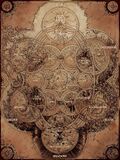- For the mage specialization, see Mage#Arcane. For the magic school, see Magic schools#Arcane. For users of arcane magic, see Arcanist.

A mage channeling arcane energy.
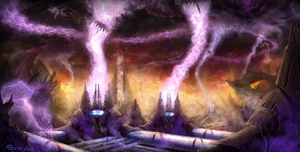
Manaforges are used to harness the magic from the tumultuous storms in Netherstorm.
“This is not for idle hands, nor prying eyes. Information must not be lost. But it must not be used unwisely. Stay your hand, friend, or proceed—if you know the way.”
Arcane magic (also called arcane energy,[2] or arcana)[3] is a cold and intellectual[4] magic that warps time, space, and controls the flow of mana,[5] which is just a measure of a fundamental power—if mana were water, then arcane would be steam pressure.[6] Though extremely volatile, arcane is so similar to an element it might as well be one, for all magical intents and purposes.[1] While arcane represents order, fel is the magic of chaos and disorder,[7] and are considered opposite ends of the same spectrum.[8]
Origins and characteristics
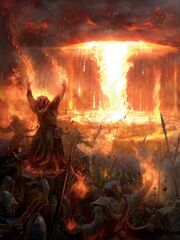
Magi creating a gigantic fire storm.
Order is most commonly perceived in reality as arcane magic. Arcane energy is innately volatile, and wielding it requires intense precision and concentration. Disorder, on the other hand, manifests as highly destructive fel magic, a destructive and extremely addictive energy originating as a result of the mutual destruction of Light and Void as they collide on a cosmic scale in the Twisting Nether.[9]
Arcane energy is thus countered by fel energy, and is fundamentally opposed to it.[10] Arcane is also largely present in the Twisting Nether. Arcane magic can be pulled from ley lines,[11] channels of immense magical power that course through Azeroth itself.[12] The ley lines are like blood vessels of the planet, carrying arcane magic instead of scarlet fluid.[13] Volatile arcane energies is described as the lifeblood of the nascent titan of Azeroth.[14]
Pure arcane appears white and/or violet.[15] However, when used to bend other types of magic, it takes on the characteristics and appearance of those magics. Examples of this can be seen with element-based abilities used by mages,[16] or the bronze glow of chronomancy.[17][18]
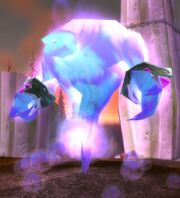
An arcane construct.
Arcane, like all other types of magic, can be animated. An example of this are the arcane elementals. Wielders of arcane magic are usually called mages. They mostly use it to create portals or teleport people and objects. The Council of Six cast a powerful spell to teleport the entirety of Dalaran to the Broken Isles. Arcane magic can be used with other types of magic to reinforce them. An example of this is Archmage Khadgar infusing ice with arcane, rendering it extremely resilient, so much that it nullified the fel assault of Gul'dan entirely. He also used arcane magic to create an arcane-wedge along with arcane elementals that would use the wedge to hammer and pierce the floor where he was trapped.[19] The night elves and then the nightborne elves became virtually immortal by feeding on potent sources of arcane energy, the Well of Eternity and the Nightwell respectively.[20]
In general, arcane magic can be used to do nearly everything, as it can be used to manipulate both space, and time. It can be used to create objects such as food or drinks from nothing. Arcane can be used to turn oneself invisible, to become inaudible, to create multiple images of oneself, or to polymorph objects and people into something else entirely as well as to communicate from afar. It can be used to animate constructs and objects such as arcane golems or brooms, to power machinery, to rewind time, access alternate timelines,[21][22][23] see the future, or the past, to scry,[24] conjure illusions, or simply to cause massive destruction.
The history of arcane on Azeroth
Primordial Azeroth
When Aman'Thul ripped the Old God Y'Shaarj out from Azeroth, it created a gaping hole in the planet's crust itself from which arcane energy was hemorrhaging. After the war against the Black Empire, the Keepers healed the wound in the form of a lake of scintillating energies that they named the Well of Eternity. Its potent energies would nurture the bones of the world and empower life to take root in the land's rich soil.[25]
The titan Norgannon — Keeper of Celestial Magics and Lore — blessed Malygos with a portion of his vast power. From then on, Malygos would be known as the Spell-Weaver, the Aspect of magic and hidden arcanum.[26]
Constructed by the Keepers, the Halls of Origination are filled with ancient relics and the fearsome guardians that protect them. Isiset served to regulate the arcane energies contained within, and produced by, the Halls of Origination.[27]
The kaldorei and the Well of Eternity
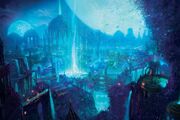
In time, a primitive tribe of nocturnal trolls cautiously made their way to the edges of the mesmerizing, enchanted lake. The feral, nomadic humanoids drawn by the Well's strange energies built crude homes upon its tranquil shores. Over time, the Well's cosmic power affected the strange tribe, making them strong, wise, and virtually immortal.
The early night elf priests and seers studied the Well with an insatiable curiosity, driven to plumb its untold secrets and power. Azshara, the night elves' beautiful queen, shared the priests' curiosity towards the Well of Eternity, and ordered the educated Highborne to plumb its secrets and reveal its true purpose in the world. The Highborne buried themselves in their work and studied the Well ceaselessly. In time they developed the ability to manipulate and control the Well's cosmic energies.[28] They harnessed the powers of the Well of Eternity with such skill that they attracted the attention of the Burning Legion. Indeed, their studies were in fact sending ripples of energy through the Great Dark Beyond, notifying Sargeras of Azeroth's location. The War of the Ancients resulted, and the Well was eventually destroyed, sundering Kalimdor.[29] The well collapsed into itself. Its waters became the center of the Great Sea, and an immense, violent whirlpool formed where the Well had once been. Called the Maelstrom to this day, the water churns constantly in a dizzying storm of tidal and arcane energy that seems to have no end.[30]
Illidan's gift
Just before the Well imploded, Illidan Stormrage, who practiced the Highborne's magics, had filled several vials of its powerful waters. He was certain that despite the night elves' victory, the Legion would one day return. Despite the grueling war that had just ended, he believed that arcane magic was necessary to fight the Legion back. Thus, he sought out a secluded lake atop Mount Hyjal and poured three of the vials into its waters, irreversibly changing the lake into a smaller Well of Eternity.[31]
Exile of the high elves
The surviving Highborne were forbidden to practice arcane magic[29] and they were awed by what Illidan accomplished. They soon grew bold in defying the new laws against arcane magic. They would not bow to the hysterical fears of the lower-caste majority. The Highborne felt they had taken all the necessary precautions by resolving to be more cautious than their predecessors. After all, the Highborne had no desire to bring about another Sundering. Rather than execute the Highborne, the rest of the night elves sentenced them to exile. The Highborne were thoroughly exasperated by what they saw as a foolish overreaction against sorcery. They were therefore not unhappy at the prospect of exile; on the contrary, they looked forward to it. Thinking ahead, they contrived to steal one of the magical vials that had been confiscated from Illidan.[32]
Banished to the Eastern Kingdoms, the Highborne began seeking a new homeland, within which they could practice their magic freely. They founded the nation of Quel'Thalas and created the Sunwell, a new magical fount, using water from the original Well, and became high elves.[29] The Sunwell's arcane magic was the heart of high elf society, empowering many of their day-to-day spells. The high elves, some of them eventually renaming themselves the blood elves, retain a deep affinity for the arcane.[33]
Human magi
In later years, the high elves of Quel'Thalas began to teach humans the arcane arts. These humans founded the city state of Dalaran and formed the organization of the Kirin Tor magi as its ruling council.[29]
Arcane bombs
Arcane bombs are weapons designed to fight spellcasters. They drain mana, inflict damage, and prevent spellcasting for a short time.
Focusing Iris

The Focusing Iris
The Focusing Iris is an orb of immense power, capable of magnifying and focusing arcane energy.[34] Malygos used it to create and direct surge needles.[35] Its energy was used to animate Chromatus and to fuel the mana bomb that destroyed Theramore.[36] Jaina once used it to create a gigantic tidal wave of water elementals to destroy Orgrimmar, but she was stopped by Thrall.
Mana bombs
Mana bombs are powerful explosive devices developed by the blood elves. They are fueled by pure arcane energy and kill instantly.[37]
The arcane energies released by the Focusing Iris-powered mana bomb dropped on Theramore turned the people purple for a fraction of a heartbeat before they exploded in a cloud of lavender ash. Those further from the center of the blast were frozen like statues but crumbled into shining violet dust when touched. Jaina Proudmoore, barely surviving the blast due to Rhonin pushing her through a portal, found herself radiating with arcane energy and that nearly all of her once golden hair had turned to moonlight white.[1]
Mana gems
Mages have the ability to store mana into gems for future use without alchemical aid.[38]
Surge needles
Surge needles are massive constructs made of stone and arcane energy used to tap into or manipulate ley lines. Malygos used them to redirect the ley lines of Azeroth to the Nexus.[39]
In Netherstorm
In Netherstorm, there are eco-domes and manaforges made from the arcane.
Arcane wells
The first Well of Eternity
The Well of Eternity was made from the very lifeblood of the nascent Azeroth titan, which was hemorrhaging out from the wound left behind by Y'Shaarj. Volatile arcane magic was once concentrated in the Well of Eternity, but its destruction during the War of the Ancients spread arcane power throughout the world.[29] Its energies are still raining down from the skies to this day.
The Nightwell
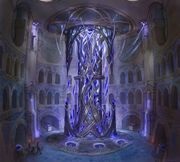
The Nightwell within the Nighthold.
Elisande and her followers harnessed the Eye of Aman'Thul, one of the Pillars of Creation, to create an immense fount of arcane magic. Known as the Nightwell, this source of power would nourish the sorcerers for thousands of years, and protect them from future threats. In millennia to come, the fount would also change Elisande and her allies, transforming them into the nightborne.[40]
The second Well of Eternity
Before the Great Sundering, Illidan had filled several vials with enchanted liquid from the original Well of Eternity. He poured some of them into the lake atop Mount Hyjal, transforming the idyllic waters into another fount of arcane power.[41] The dragon Aspect Alexstrasza would then plant the world-tree Nordrassil in the fount to prevent the Burning Legion from using it as an entry to Azeroth.
Moonwells
Moonwells are hallowed repositories of a mix between the sacred waters of the Well of Eternity[42] and the magic of nature. Druids take advantage of the moonwells' properties, which provide growth and protection to their surrounding lands, and the Sentinels revere the wells as shrines to Elune.[43]
The Sunwell
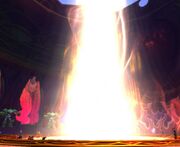
The Sunwell in its current state.
Just before the Highborne had been exiled from Mount Hyjal, Dath'Remar Sunstrider had secretly taken one of Illidan Stormrage's remaining vials from the custody of the night elves. Dath'Remar poured the vial into a small lake at the center of a nexus, and a brilliant fount of energy tore through the skies of Azeroth. The Highborne dubbed this glorious cradle of power "the Sunwell", a name chosen in honor of Dath'Remar and his bold quest to reignite their culture.[44] It was destroyed during the Scourge invasion of Quel'Thalas. The prophet Velen sanctified the legendary Sunwell using the power of the Light, reigniting it as a fount of both arcane power and Holy Light.[45]
The Shrine of Lost Souls
Illidan used the fount of arcane energy beneath the Black Temple to free demons of their addiction to the Legion's fel magic and bind them to his service. Kanrethad Ebonlocke believed that this same power source is what Illidan intended to offer the blood elves to free them of their addiction to the Sunwell.[46] Strangely, its properties resembled greatly the Well of Eternity's.
The Arcway
This labyrinthine complex built thousands of years ago runs beneath the foundations of Suramar's largest buildings, delivering the Nightwell's energies throughout the city. Before the creation of the Nightwell, it was used to deliver the energy of the ley lines beneath the land of Suramar.
Arcane wielders
In the Warcraft universe, there is an instability, and those skilled in arcane magic have learned how to exploit that instability,[47] being able to control the elements and other forces such as time.[48]
Arcane creatures
 Arcane elementals,
Arcane elementals,  Mana surges, and
Mana surges, and  Arcane wraiths are manifestations of volatile arcane energy and are innately chaotic.
Arcane wraiths are manifestations of volatile arcane energy and are innately chaotic.
 Arcane Constructs are intelligent but unpredictable, spawned of pure mana, and allow their user to quickly assimilate large amounts of arcane knowledge. They are very vulnerable to external tampering.[49] The high elves outlawed them around 1,500 years ago, but the new era of Highborne have begun using them.[50]
Arcane Constructs are intelligent but unpredictable, spawned of pure mana, and allow their user to quickly assimilate large amounts of arcane knowledge. They are very vulnerable to external tampering.[49] The high elves outlawed them around 1,500 years ago, but the new era of Highborne have begun using them.[50]
 Arcane golems are robotic constructs powered by arcane energy. They are found prominently in blood elf zones and primarily serve as public defenders.
Arcane golems are robotic constructs powered by arcane energy. They are found prominently in blood elf zones and primarily serve as public defenders. Mana wyrms are attracted to and feed off arcane energies. They are commonly found in Quel'Thalas around fel crystals and were used as guardians. Blood elves have been known to drain magic from mana wyrms to sate their arcane addiction. Most recently, mana wyrms have been utilized by Sunreavers on the Isle of Thunder to fight Kirin Tor magi.[51]
Mana wyrms are attracted to and feed off arcane energies. They are commonly found in Quel'Thalas around fel crystals and were used as guardians. Blood elves have been known to drain magic from mana wyrms to sate their arcane addiction. Most recently, mana wyrms have been utilized by Sunreavers on the Isle of Thunder to fight Kirin Tor magi.[51] Sparks
Sparks
Blue dragons
The blue dragons are the foremost experts on arcane magic.[52] After the ordering of Azeroth, the titan Norgannon blessed Malygos and his flight with immense knowledge and power over the arcane, and the duty of ensuring it would never be abused.
Ethereals
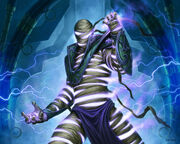
An ethereal wrapped in enchanted strips of cloth.
Dimensius the All-Devouring opened countless gateways into the void and the Twisting Nether around the ethereals' homeworld, K'aresh, bathing it in arcane and dark energies. The unimpeded flood of arcane energy tore away the then-mortal race's corporeal shells and infused their souls with enough energy so that they could subsist without a body. Members of this race, now called ethereals, took to binding themselves with enchanted strips of cloth to provide their souls with enough structure to survive.[53]
High elves
The high elf race was fundamentally changed from being constantly suffused in magic. As the few survivors of the Scourge's invasion grew ill and apathetic, it became clear that they had become addicted to the Sunwell's arcane energies. With their source of magic gone, they all suffered acute pangs of withdrawal, spellcasters and non-spellcasters alike. Kael'thas publicly asserted that his people would die unless they found a new source of magic, but was technically mistaken. Only the very old, the very young, and elves already in poor health died from magical withdrawal. Certain magical artifacts can ameliorate and even suppress the symptoms of withdrawal. Withdrawal from arcane magic can result in permanent mental or physical damage.[54][55]
Nether drakes
When Draenor was torn apart from the magical stress of Ner'zhul's multiple portals, the arcane energies released altered the black dragon eggs left there by Deathwing. This resulted in the nether drakes: ethereal dragons whose bodies are composed of energies from the Twisting Nether.
Trolls
The savage trolls of Azeroth are infamous for their cruelty, dark mysticism, and seething hatred for all other races. Without Lei Shen, the Thunder King, trolls knew they would never fully learn the secrets of the arcane.[56] The trolls found the mogu's knowledge of arcane magic useful and, eventually, dark trolls discovered an enormous lake of scintillating energies, a lake they would later know as the Well of Eternity. Mesmerized by their discovery, the dark trolls settled along the Well of Eternity's shores. Over generations, the energies radiating from the lake suffused the trolls' flesh and bones, elevating their forms to match their graceful spirits. They transformed into highly intelligent and virtually immortal beings. These former trolls gradually abandoned their ancient heritage and traditions. The tribe's mystics began worshiping the moon goddess, Elune, who they believed was bound to the Well of Eternity itself. They claimed that the deity slumbered within the fount's depths during daylight hours. The former trolls also discovered the name "Kalimdor" and other titan-forged worlds from communing with Elune and investigating strange artifacts scattered around the Well's periphery. Influenced by this newfound language, they called themselves kaldorei—"children of the stars"—or night elves.[57]
Wretched
The wretched are desperate and demented criminals who had siphoned arcane magic in amounts exorbitant, causing them to physically transform them into emaciated, reckless, black-hearted fiends who would gladly kill for a few mana crystals.[58]
Demon hunters
Demon hunters, disciples of Illidan Stormrage, uphold a dark legacy, one that frightens their allies and enemies alike. The Illidari embrace fel and chaotic magics, believing them necessary to challenge the Burning Legion. To keep their fel forces in check, they mark their bodies with arcane runes.[10]
Druids
By leveraging the sacred powers of the moon, the sun and the stars, balance druids access arcane and nature magics, made more potent still through shapeshifting into a moonkin.[59]
Hunters
Some hunters can conjure arcane ammunition.[60] They can also tame arcane-related creatures such as the nether ray and the warp stalker.
Mages

Khadgar, perhaps the most accomplished of all living wizards.[61]
Magi are arcane spellcasters who favor magiks involving the cardinal elements of the universe. Students gifted with a keen intellect and unwavering discipline may walk the path of the mage. The arcane magic available to magi is both great and dangerous, and thus is revealed only to the most devoted practitioners. To avoid interference with their spellcasting, magi wear only cloth armor, but arcane shields and enchantments give them additional protection. To keep enemies at bay, magi can summon bursts of fire to incinerate distant targets and cause entire areas to erupt, setting groups of foes ablaze.[62]
Mages of the arcane are diviners of secrets, balancing the ebb and flow of incredible mystic energies. Unparalleled skill is required to manipulate the volatile forces of the universe. These practitioners push their magical knowledge to its very limits—often to the brink of their own exhaustion, and at great risk to the world around them. Those who master this craft are capable of releasing a barrage of unrelenting power upon their enemies, drawing upon replenishing energies to maintain their assault for as long as the battle demands.[5] Mages are often aged from the stress of the magical energies they wield, causing their hair to prematurely turn gray.[63]
When Illidan Stormrage absorbed the power of his Moon Guards, he used the arcane power of the cosmos and stars to annihilate the Burning Legion.[64]
Nethermancers like Sepethrea and Zerevor utilize arcane spells.
Warlocks
Some warlocks were former mages that delved too deeply into the roots of demonic power.[65] There are also some who deliberately chose to follow this path to understand how to fight demons better, like Daio the Decrepit.
Schools of arcane magic
The mages of the Kirin Tor have divided the eldritch arts into eight[note 1] different categories. All schools of magic can be combined to create formidable spells that utilize multiple sources of power. Mages are cautioned about the dangers of combining multiple types of magic.[66]
Abjuration
Abjuration is the study of protective magic. The most generalized abjuration spell is the mana shield, a spell that transmutes raw mana into a barrier that protects the caster from attacks. Elemental armor spells require far less raw energy than a mana shield and are more easily maintained over time, but lack the raw potency of the mana shield. Ward spells are quick, potent incantations to protect the caster against a form of magical damage, often caused when magic slips out of a mage's control.[67]
Conjuration
Conjuration is the study of magically creating creatures and objects. There is nothing more enjoyable for a mage than creating a fresh slice of bread or a glass of water.[68] Mages can combine water and air vapors into a water elemental for a short time before they deconstruct into their base liquid forms.[69] The elemental attacks that mages use are a form of conjuration.[70]
Divination
Divination is the school of magic dedicated to gathering information. Powerful divinations can allow the mage to see targets from a great distance, or even view what may normally be invisible. One of the most common uses of divination magic is scrying, which is the art of seeing something that may be far away—perhaps even on another plane of existence.[71] Divination spells can be used to counteract Illusion spells.[72]
Enchantment
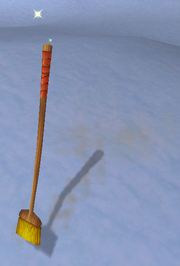
Enchanted brooms can be seen sweeping the streets of Silvermoon City.
- See also: Enchanting
Enchantment is the process of imbuing an object—or person—with magical power. Some enchantments are temporary, while others can offer permanent benefits. Disenchanting is the process of dispelling or removing magic. The dispel magic spell is among the most important in a mage's arsenal, as it can potentially reverse the catastrophic effects of a misfired spell. It is also possible to permanently ![]() [Disenchant] a magical item. This process produces a unique form of crystallized mana that can be used in the process of imbuing another item with magical abilities.[73] Conjured water elementals could possibly be considered to be water animated by enchantment.[74][75]
[Disenchant] a magical item. This process produces a unique form of crystallized mana that can be used in the process of imbuing another item with magical abilities.[73] Conjured water elementals could possibly be considered to be water animated by enchantment.[74][75]
Servants of the undead study arcane in order to imbue their weapons and armor with unholy power.[76]
Illusion
Illusion is the art of deceiving reality itself. The mists of illusion can make a mage invisible or inaudible to the world or twist the image of a location into something entirely different. Illusion can be used for disguise or manipulation, but spells to counteract illusions exist in the divination school. Illusions can be used to trick your enemies into fighting each other and be used to display several images of a mage's body that are nearly indistinguishable from the caster's real form.[72]
Transmutation
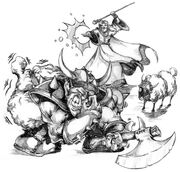
Polymorph transforming an orc into a sheep.
The ninth[note 1] and final school of magic is transmutation. It is among the most popular and useful of all of the schools, allowing a mage to manipulate time and space. Perhaps the most iconic Transmutation spell is ![]() [Polymorph], which allows a mage to temporarily turn something—or someone—into something else.[77] It is possible, but unadvised, to increase the intelligence or power of a creature through polymorph, polymorph into exotic creatures, and polymorph inanimate objects.[78]
[Polymorph], which allows a mage to temporarily turn something—or someone—into something else.[77] It is possible, but unadvised, to increase the intelligence or power of a creature through polymorph, polymorph into exotic creatures, and polymorph inanimate objects.[78]
The second most famous use is teleportation. The most basic teleportation spell is ![]() [Blink]. Attempts to cast a teleportation "on the fly" often result in one very dead mage inside a wall, chair, or another mage.[77] A properly used portal is just as safe as the average zeppelin trip, but frequent use of teleportation wears down the infrastructure of the ley lines.[79]
[Blink]. Attempts to cast a teleportation "on the fly" often result in one very dead mage inside a wall, chair, or another mage.[77] A properly used portal is just as safe as the average zeppelin trip, but frequent use of teleportation wears down the infrastructure of the ley lines.[79]
Spells that manipulate time also fall into this category, such as ![]() [Slow Fall],
[Slow Fall], ![]() [Slow], and spells that increase movement speed.[77] This particular arcane art is known as chronomancy.
[Slow], and spells that increase movement speed.[77] This particular arcane art is known as chronomancy.
Necromancy
- Main article: Necromancy
While the Kirin Tor consider necromancy to be a school of arcane and it has been described as an arcane art,[80][81][82] World of Warcraft: Chronicle Volume 1 explains that necromancy is a separate branch of magic part of Death magic. Necromancy is the study of magic involving the dead. It is highly illegal and should be avoided at all costs. Necromancers and their followers are the enemies of all living things. Necromantic magic has many functions beyond simply raising the dead. Masters of this tainted field of magic can conjure festering diseases, harness the shadows into bolts of incendiary energy, and chill the living with the power of death. Necromancy can also be used to reconstruct the flesh of undead creatures, allowing them to function again even after the foul monsters have been destroyed.[83]
Evocation
This article or section includes speculation, observations or opinions possibly supported by lore or by Blizzard officials. It should not be taken as representing official lore.
|
In the RPG, Evocation is one of the eight schools of magic. The in-game book on Abjuration implies that Evocation is a separate school, noting that Arcanist Doan had perfected a spell that combines Evocation with Abjuration to shield himself for a short time while preparing a powerful area-of-effect spell. ![]() [Incanter's Ward] seems to be a weaker variant of the spell Doan used.
[Incanter's Ward] seems to be a weaker variant of the spell Doan used.
There are several in-game examples of evokers among the ranks of several organizations, such as the Scarlet Crusade, the Defias Brotherhood and the Bloodaxe Legion, among others.
This school is likely the art of gathering magical energy or focusing one's mind. The spells ![]() [Evocation],
[Evocation], ![]() [Rune of Power],
[Rune of Power], ![]() [Presence of Mind], and
[Presence of Mind], and ![]() [Incanter's Flow] would fall under this school.
[Incanter's Flow] would fall under this school.
In Dungeons & Dragons, Evocation is one of the nine schools of magic and is used to manipulate energy or tap unseen sources of power. All of the other D&D schools are represented in Warcraft—with Alteration folded into Transmutation. This would seemingly explain why Warcraft's Transmutation book notes it as the ninth and final school, while the Introduction says there are only eight.
The laws of arcane magic

"Arcane magic doesn't follow normal rules of nature. Opposites definitely do not attract." - Belmaril, Timewalker Bloodmage.
The four rules
There is a set of rules that governs the destiny of every person that chooses to continue down the path of a mage. These guarantees are:
- Magic is powerful.
- Magic is corrupting.
- Magic is addicting.
- Magic draws the denizens of the Twisting Nether to those who wield the arcane.[84]
Law of sympathy
The sympathy between a subject and the object used by her becomes stronger with a more constant and thoughtful use. As auras vary with individuals, the vibration makes it possible to connect to the individual by affecting the item, and vice versa.[86]
Among its practical uses, sympathy may allow a lock of hair to be used in a love charm, or a coin to be tracked back to its original owner. Similarly, an expert can read handwritten letters or books without having to actually read them.[86]
Even before Warp-Scryer Kryv deciphered the ![]() [Burning Legion Missive], he had been able to sense the hatred and urgency woven into the scroll.[87]
[Burning Legion Missive], he had been able to sense the hatred and urgency woven into the scroll.[87]
Notes
- ^ a b The Schools of Arcane Magic - Introduction says there are eight, but Transmutation is noted to be the ninth. There are only seven books available in the game.
- The arcane blade
 [Felo'melorn] was crafted on an arcane forge by Luminarian.[88]
[Felo'melorn] was crafted on an arcane forge by Luminarian.[88] - Aluneth is described as an entity of pure arcane energy.[89]
- Arcane was once described as chaotic in nature,[90] this has been changed so fel represents chaos while arcane represents order.[91] That being said, there are still many instances where arcane is described as being chaotic or volatile. For instance, the Rift within the Nexus released arcane beings such as Anomalus, Chaotic Rifts and Crazed Mana-Wraiths. The dialogue of Anomalus is particularly chaos-aligned.[92] Those skilled in arcane magic are said to exploit the "inherent instability" of the universe.[47]
- This is because arcane is still described as volatile and chaotic to wield, requiring perfect order and control to use correctly.
- Alternatively, ordered patterns overwriting each other would still be effectively chaotic.
- Shaman were once described as arcane masters.[76]
In the RPG
Important note: While many elements differ between the RPG and game canon, this is especially true for information on arcane and divine magic. Though the origin of the sources of magic is the same, their implementation and effect on the world is wholly different. Most notably, in the RPG, Divine magic is overall good, while arcane magic is overall bad. In canon, arcane magic still has more corruptive elements than divine magic, but it is not corruptive in and of itself.
History
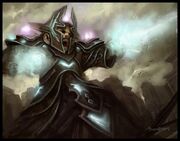
Arcane magic is the gift of titans to the world, a gift that comes with the highest price. Thousands of years ago, the titans placed the Well of Eternity in the center of Kalimdor to serve as a source of restoring, life-giving energy. They intended that the Well's energies would empower life of all forms to emerge on Kalimdor — plants, animals, monsters, races.
After a time, the titans left Azeroth, leaving Kalimdor in the hands of the five dragon Aspects. Yet the Well of Eternity proved too great a lure to remain hidden for very long, particularly from Sargeras and the Burning Legion.
The Well was discovered by the kaldorei, who were later known as night elves. Ever eager to uncover secrets hidden in dark places, the Kaldorei listened to the Well as it promised to give them great power. At the Well's behest, the Kaldorei learned spellspeech and used it to weave the first arcane spells. Within decades, Kaldorei mages had attained sufficient mastery over arcane magic that they built a great civilization. They founded the imperious city of Zin-Azshari, from which they extended their domination over most of Kalimdor.
Ultimately, the magic corrupted them. The kaldorei had been a simple folk who gazed blissfully at the stars, enjoying the immortality given to them by the Well, but their haughtiness robbed them of that gift forever. Each succeeding generation became prouder and more decadent, and the lust for power only made the Kaldorei more of a beacon to the lords of the Twisting Nether.
Finally, their greatest mage, Queen Azshara, cast a spell in the heart of the Well of Eternity itself — and a way was opened for evil to invade the world. Through Azshara's breach came the Burning Legion, the most terrifying warriors in existence. This fiendish horde ravaged Azeroth, pillaging entire kingdoms, destroying all that stood in its path, mocking anyone who begged it for mercy.
When the Burning Legion ravaged the land, great heroes recognized that arcane magic posed a continuing threat to all living creatures, so they elected to destroy the Well of Eternity and put an end to arcane magic forever. Unfortunately, among their number was one Illidan Stormrage, an arcane spell caster who dreaded the thought of losing his powers. Secretly he stole some of the well's water and used it to create a new Well of Eternity at Mount Hyjal, thus preserving the power of the arcane. This theft allowed future elven generations to follow in the footsteps of Illidan and Queen Azshara. These elves called themselves the Quel'dorei, "the high elves" (for they believed that their mastery of the arcane elevated them to higher status). They also taught the arcane arts to the newly discovered race of humans, who showed a natural aptitude.
These human mages, however, were even more reckless than the night elves had been. The high elf mages warned their human pupils that magic was addictive, but the acolytes dismissed any suggestion that the tragedies that had befallen the elves would also afflict them. The humans were no better at resisting corruption than the elves had been, and eventually the arrogance of wizards brought the Burning Legion to Azeroth once more. Once again, great acts of heroism were needed to spare Azeroth from destruction.
Elsewhere, on the orcish home world of Draenor, arcane sorceries corrupted the once noble race of orcs, transforming them into the Horde, a nigh invincible army. After ravaging their home world, the orcs came to Azeroth; and with their warlocks, they waged two great wars against the races of human, elf and dwarf. The orcs failed to seize control of Azeroth; during these wars, Draenor itself was utterly destroyed, and the orcs were forced to relocate to Azeroth.
In the wake of the Third War against the Scourge and Burning Legion, the orc Warchief Thrall has rejected arcane magic and embraced his race's traditional shamanistic ways. Yet orc warlocks still walk the world, and demons whisper in their ears each time they cast a spell. Neither human nor high elves have abandoned the pursuit of the arcane; if anything, the defeat of the Burning Legion at the Battle of Mount Hyjal has fed the arrogance of many spell casters, who believe the world is now protected from demonic influences and that arcane spell casters may practice their art in relative safety. Nothing sows the seeds of the fields of tragedy quite like arrogance.[93]
The four laws
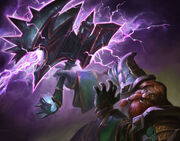
A weapon being destroyed by arcane magic.
- Magic is powerful.
Magic in Azeroth is the difference between a slave and a master, a foot soldier and king. Few races and nations can operate without powerful mages and warlocks. The use of arcane magic is growing; historically, each time this has happened before, a great disaster shortly follows. However, even though the history of the arcane is well known, mages and their patrons invariably come to the same self-serving conclusion: It won't happen to them.
- Magic is corrupting.
Magic corrupts the soul; if the humblest person in Azeroth became a practitioner of the arcane, by the time the practitioner reached the higher levels in their art, all traces of her humble roots would be lost. Magic breeds pride and arrogance. Magic corrupts the body; it ages the caster before their time and hastens the blight that the world inflicts on things fair and beautiful. Those who claim that only necromancy and fel magic have a corrupting influence are fooling themselves.
- Magic is an addiction.
When one feels the power of an arcane spell coursing through one's body as it's being cast, resisting the urge to cast it again is difficult. Frequent use leads to a desire for more and, eventually, to a desire for the evil fel energy.[94]
- Magic attracts the Twisting Nether like flies to honey.
The Burning Legion has invaded Azeroth three times, drawn by the power of the Well of Eternity and those who employ it. Magic is a literal gateway drug that allows dark titans such as Sargeras to bring evil influences to the world. Those who employ arcane magic must deal with demons and other servants of the Twisting Nether.[95]
See also
- Technomancy
- Time (chronomancy)
References
- ^ a b c Jaina Proudmoore: Tides of War
- ^ Matt Burns on Twitter
- ^ Dark Riders
- ^ Thrall: Twilight of the Aspects pg. 150 on e-book
- ^ a b Legion Class Preview Series: Mage
- ^ Dave Kosak on Twitter (2014-04-27)
- ^ Dave Kosak on Twitter (2015-11-10)
- ^ Dave Kosak on Twitter (2015-12-03)
- ^ World of Warcraft: Chronicle Volume 1
- ^ a b

 [10-45] Opposites Repel
[10-45] Opposites Repel
- ^ War Crimes, pg. 359 on e-book
- ^ World of Warcraft: Paragons, pg. 584 on e-book
- ^ Arthas: Rise of the Lich King, pg. 371 on e-book
- ^ World of Warcraft: Chronicle Volume 1
- ^ Sean Copeland on Twitter (20114-03-13)
- ^
 [Fireball]
[Fireball]
- ^ Weaver Belmaril
- ^ Hellscream
- ^ The Tomb of Sargeras
- ^ The Warcraft Encyclopedia/Night Elves
- ^
 [10-40] For the Alliance!
[10-40] For the Alliance!
- ^
 [10-40] For the Horde!
[10-40] For the Horde!
- ^ The Everbloom#Dungeon Journal
- ^ Heart of Rage (old) (Horde)
- ^ Warcraft III: Reign of Chaos manual#The Titans and the Ordering
- ^ Charge of the Dragonflights
- ^ Halls of Origination#Dungeon Journal
- ^ Warcraft III: Reign of Chaos manual#The Kaldorei and the Well of Eternity
- ^ a b c d e Ultimate Visual Guide
- ^ Ultimate Visual Guide, pg. 18
- ^ The Sundering, chapter 22
- ^ The Warcraft Encyclopedia/Dath'Remar Sunstrider#Escape from Zin-Azshari
- ^ Blood of the Highborne
- ^ Jaina Proudmoore: Tides of War, pg. 533
- ^ Jaina Proudmoore: Tides of War, pg. 52
- ^ Jaina Proudmoore: Tides of War, pg. 552 - 553 (ebook)
- ^ Jaina Proudmoore: Tides of War, pg. 383 (ebook)
- ^ Heroes of Azeroth, 57
- ^ Golden, Christie. "Fifteen", Thrall: Twilight of the Aspects. ISBN 978-1439-19663-2.
- ^ World of Warcraft: Chronicle Volume 1 pg. 218 - 219 on e-book
- ^ World of Warcraft: Chronicle Volume 1 pg. 232 on e-book
- ^ Warcraft III: Reign of Chaos manual#Moon Well
- ^ Crown of the Earth (quest)
- ^ World of Warcraft: Chronicle Volume 1 pg. 251 on e-book
- ^ Wrath of the Lich King manual, pages 8 - 9: Winds of Change: From Dark Horizons to a Beacon of Hope in the World of Warcraft
- ^

 [35] Infiltrating the Black Temple
[35] Infiltrating the Black Temple
- ^ a b Ask CDev Answers - Round 4
- ^ Weaver Belmaril#Quotes
- ^
 [5-30] Arcane De-Construction
[5-30] Arcane De-Construction
- ^
 [5-30] Hacking the Construct
[5-30] Hacking the Construct
- ^
 [32-35P Daily] Mana Scavengers
[32-35P Daily] Mana Scavengers
- ^ The Old Wizard's Almanac
- ^ Ask CDev Answers - Round 1
- ^ The Warcraft Encyclopedia - High Elves
- ^ The Warcraft Encyclopedia - Blood Elves
- ^ World of Warcraft: Chronicle Volume 1 pg. 171 - 172 on e-book
- ^ World of Warcraft: Chronicle Volume 1 pg. 194 - 195 on e-book
- ^ World of Warcraft: Paragons pg. 686 on e-book
- ^ Legion Class Preview Series: Druid
- ^
 [Arcane Shot]
[Arcane Shot]
- ^ Warlords of Draenor Official Site "Perhaps the most accomplished of all living wizards..."
- ^ World of Warcraft > Game Guide > Classes > Mage
- ^ The Last Guardian, pg. 31 (ebook)
- ^
 [45] Ravencrest's Legacy
[45] Ravencrest's Legacy
- ^ http://web.archive.org/web/20031002110845/http://www.blizzard.com/wow/townhall/classes.shtml#warlock
- ^ The Schools of Arcane Magic - Introduction
- ^ The Schools of Arcane Magic - Abjuration
- ^ The Schools of Arcane Magic - Conjuration
- ^ Warcraft III: Reign of Chaos Game Manual#Archmage
- ^ Warcraft: Orcs & Humans manual#Conjurer Spells
- ^ The Schools of Arcane Magic - Divination
- ^ a b The Schools of Arcane Magic - Illusion
- ^ The Schools of Arcane Magic - Enchantment
- ^ Warcraft III: Reign of Chaos Game Manual#Water Elemental "Water elementals were a favorite tool of the Conjurors of Azeroth during the First War, and now the enchanted creatures have come to aid the defenders of freedom once again."
- ^ Golden, Christie. "25", Jaina Proudmoore: Tides of War, 533 (ebook). ISBN 978-1416-55076-1. “Jaina laughed. Then she made more. And more still, until there was scarcely any unenchanted water to be seen.”
- ^ a b Warcraft III: Reign of Chaos Game Manual
- ^ a b c The Schools of Arcane Magic - Transmutation
- ^ Polymorphic Rules & Regulations
- ^ Thinking with Portals - A Memorandum on Proper Portal Usage
- ^ Warcraft: Orcs & Humans manual#The Destiny of the Orcish Hordes, " Using the arcane powers of our Warlocks and Necromancers."
- ^ Warcraft II: Tides of Darkness manual#The Rise of the Shadow Council, "In pursuit of furthering our magical resources, I opened a new school of magical discipline that became known as Necromancy. We began training young Warlocks in the arcane mysteries of life and death."
- ^ Warcraft II: Tides of Darkness manual#The Undead, "These unfortunate warriors gave their lives in battle only to be brought back into soulless servitude by arcane Orc magiks to fight for the Horde."
- ^ The Schools of Arcane Magic - Necromancy
- ^
 [Glyphic Letter]
[Glyphic Letter]
- ^ WoW TCG - Khadgar's Kilt of Abjuration
- ^ a b c The Last Guardian, 40 (ebook)
- ^
 [10-30] The Dark Missive
[10-30] The Dark Missive
- ^ Archive of the Tirisgarde#Felo'melorn
- ^ Archive of the Tirisgarde#Aluneth, Greatstaff of Magna
- ^ The Warcraft Encyclopedia/Sisterhood of Elune The Sisterhood never quite approved of way in which higher-caste night elves made use of arcane magic, due to the magic's chaotic nature.
- ^ World of Warcraft: Chronicle Volume 1
- ^ Anomalus#Quotes
- ^ Magic & Mayhem, pg. 14 - 15
- ^ Dark Factions, pg. 118
- ^ Magic & Mayhem, pg. 15
| |||||||||||||||||||

